PCBs in Water: Water Treatment Methods
- Last Updated: June 12th, 2025

Attorney Jessie Paluch, founder of TruLaw, has over 25 years of experience as a personal injury and mass tort attorney, and previously worked as an international tax attorney at Deloitte. Jessie collaborates with attorneys nationwide — enabling her to share reliable, up-to-date legal information with our readers.
Legally Reviewed
This article has been written and reviewed for legal accuracy and clarity by the team of writers and legal experts at TruLawsuit Info and is as accurate as possible. This content should not be taken as legal advice from an attorney. If you would like to learn more about our owner and experienced injury lawyer, Jessie Paluch, you can do so here.
Fact-Checked
TruLawsuit Info does everything possible to make sure the information in this article is up to date and accurate. If you need specific legal advice about your case, contact our team by using the chat on the bottom of this page. This article should not be taken as advice from an attorney.
Key Takeaways:
- PCBs have a lasting presence in the environment and can affect water quality.
- Continuous monitoring is crucial to ensure water adheres to safety standards.
- Advanced remediation methods are used to address and mitigate PCB contamination.
Overview of PCBs in Water
On this page, we’ll discuss an overview of PCBs in water, innovative water treatment methods for PCB contamination in water, advanced strategies to eliminate exposure to PCBs in drinking water, and much more.
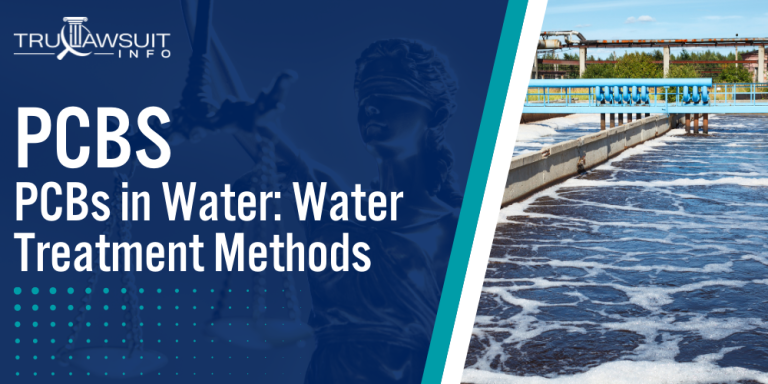
Intro To PCBs in Water Treatment Methods
These advancements stem from a pressing need to tackle PCB contamination in water sources, which poses significant environmental and health risks.
Here are the key technologies employed in treating PCBs in water:
- Activated Carbon Adsorption: Uses activated carbon to adsorb PCBs from contaminated water, effectively removing them.
- Advanced Oxidation Processes: Utilizes powerful oxidants like ozone or hydrogen peroxide to break down PCBs.
- Membrane Filtration: Employs semi-permeable membranes to filter out PCB particles from water.
- Phytoremediation: Involves the use of aquatic plants to absorb and accumulate PCBs, which are then harvested and disposed of safely.
If you or a loved one has experienced adverse health conditions after being exposed to PCBs in water, you may qualify to pursue compensation.
Contact TruLawsuit Info using the chat on this page to receive an instant case evaluation to determine if you qualify to file a PCB water contamination lawsuit today.
Table of Contents
Sources of PCB Contamination in Water
Polychlorinated biphenyls (PCBs) enter water sources through various routes, primarily from industrial and municipal activities.
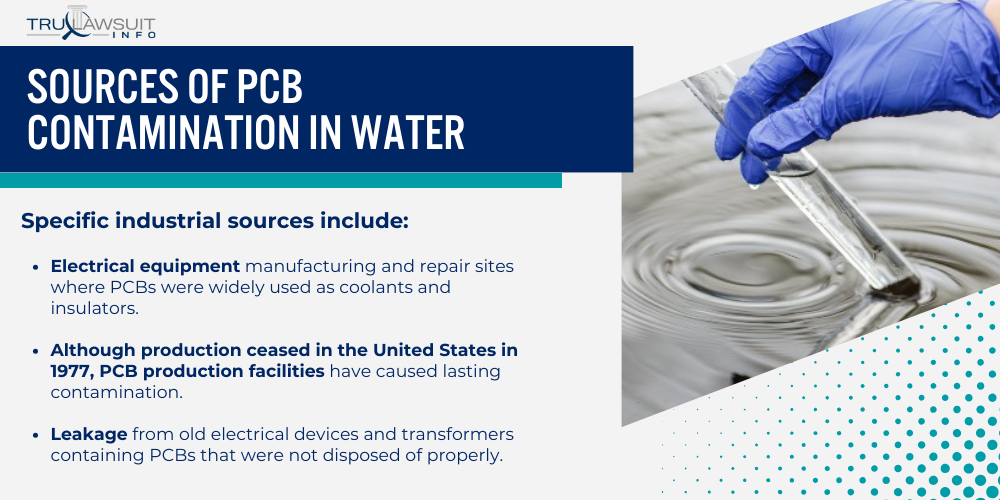
Understanding these pathways is essential for effectively addressing contamination issues.
Industrial Discharges and Leaks
Industrial activities have historically contributed to PCBs in water systems.
Specific industrial sources include:
- Electrical equipment manufacturing and repair sites where PCBs were widely used as coolants and insulators.
- Although production ceased in the United States in 1977, PCB production facilities have caused lasting contamination.
- Leakage from old electrical devices and transformers containing PCBs that were not disposed of properly.
- Incidental discharges from industrial processes that utilized PCBs in heat transfer fluids.
Atmospheric Deposition and Runoff
PCBs can be distributed far from their source due to their tendency to bind to organic particles and their persistence in the environment.
Key processes include:
- Volatilization from areas with heavy PCB use, followed by atmospheric transport and deposition.
- Runoff from contaminated sites, which then carries PCBs into the water bodies.
- Discharge from municipal and industrial incinerators, contributing to atmospheric PCB levels.
- Deposition of PCBs onto water surfaces can lead to sediment contamination, affecting the aquatic ecosystem.
Landfill Leachate and Contaminated Sediments
Landfill leachate and contaminated sediments pose severe risks to environmental health and water quality.
These hazards stem from the complex mix of pollutants that leach into the ground and water bodies from waste disposal sites.
Landfills are significant culprits in water contamination, especially:
- Municipal or other landfills that received PCB waste.
- Leachate from these landfills may seep into groundwater or surface water.
- Contaminated sediments from water bodies adjacent to these sites can be a continuous source of PCBs.
- Improper disposal of old electrical devices and PCB capacitors end up in landfills, leading to leachate generation.
Health Risks Associated with PCB Exposure through Water
Polychlorinated biphenyls (PCBs) in water pose significant health risks to humans, with exposure occurring through several environmental pathways.
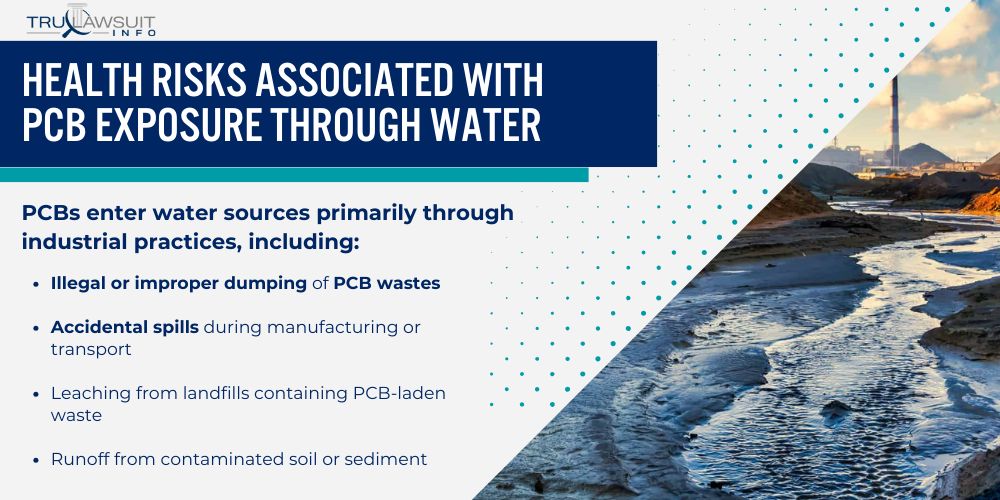
People can experience a range of harmful health effects associated with these toxic substances through the ingestion of contaminated food.
How Do PCBs Enter Water Sources?
PCBs enter water sources through various human activities, notably industrial and waste management processes.
These toxic substances contaminate our waterways due to practices such as illegal dumping, accidental spills, and runoff from polluted areas.
PCBs enter water sources primarily through industrial practices, including:
- Illegal or improper dumping of PCB wastes
- Accidental spills during manufacturing or transport
- Leaching from landfills containing PCB-laden waste
- Runoff from contaminated soil or sediment
These methods contribute to PCBs in lakes, rivers, and, ultimately, drinking water sources, presenting a challenge to environmental health.
Endocrine Disruption and Reproductive Toxicity
Exposure to PCBs through water can lead to endocrine disruption, which may affect reproductive health.
Details on these toxic effects reveal that:
- PCBs mimic or disrupt the normal functioning of hormones
- These disruptions can lead to reproductive toxicity
- Some PCB congeners are specifically known for their endocrine-disrupting potential
- Exposure to certain PCB levels may result in developmental issues in offspring
Such disturbances underscore the importance of monitoring and reducing PCB levels in water sources.
Neurodevelopmental and Immune System Impacts
Research has shown that PCBs, when present in the environment, can have detrimental effects on both the immune system and the development of the nervous system in humans.
These effects include a heightened risk of cancer, neurological impairments that can affect cognitive function and behavior, and a weakened immune response that leaves individuals more vulnerable to infections.
Exposure to PCBs has been linked to deficits in the immune system and neurodevelopmental problems:
- PCBs are considered probable human carcinogens
- They can impair neurological development, potentially leading to cognitive and behavioral issues
- Immune system suppression may result from PCB exposure, increasing susceptibility to infections
- Certain PCB congeners have demonstrated a more pronounced impact on neurodevelopment than others
Understanding the full scope of health risks imposed by PCBs in water can help implement measures to protect public health and the environment from these persistent organic pollutants.
Monitoring and Detection of PCBs in Water
Effective strategies for monitoring and detecting Polychlorinated biphenyls (PCBs) in water are crucial for maintaining safe water quality and adhering to environmental guidelines.
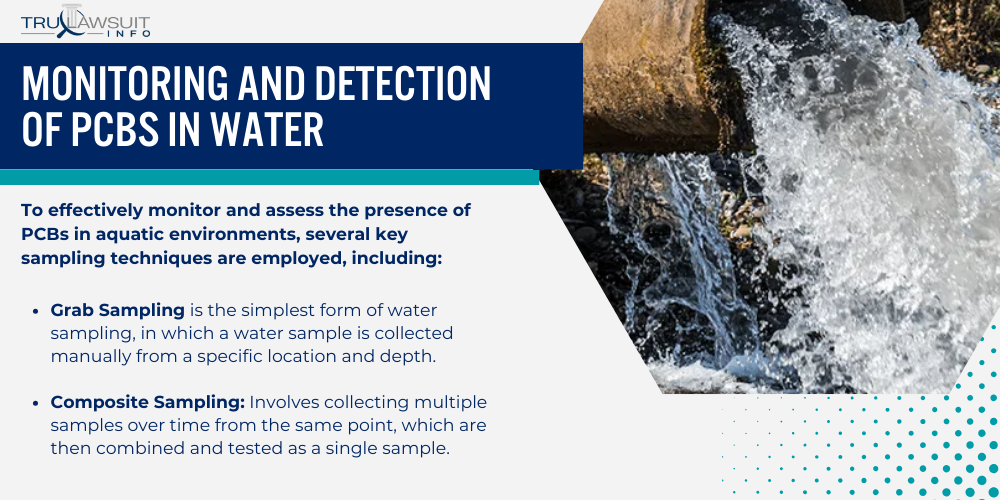
This section will discuss the current sampling techniques, analytical measurement methods, and regulatory frameworks governing PCB water resource monitoring.
Sampling Techniques for PCBs in Water
Sampling water for Polychlorinated biphenyls involves detailed protocols to ensure accurate detection levels.
The Environmental Protection Agency (EPA) guides methods that can influence results, such as choosing between filtered and unfiltered samples.
To effectively monitor and assess the presence of PCBs in aquatic environments, several key sampling techniques are employed, including:
- Grab Sampling is the simplest form of water sampling, in which a water sample is collected manually from a specific location and depth.
- Composite Sampling: Involves collecting multiple samples over time from the same point, which are then combined and tested as a single sample.
- Passive Sampling is a method in which samplers are left in the water over time and absorb PCBs, providing an integrative measure of contaminant levels.
- Depth Profiling: Involves collecting water samples at different depths to understand the concentration gradient of PCBs in the water column.
Sampling methods aim to capture the true representation of the water quality regarding PCB contamination.
Measuring PCBs in Water: Analytical Methods
For measurement techniques, laboratories deploy several analytical methods to detect and quantify PCBs in water samples.
Each method has its own detection limits and is suitable for various kinds of water matrices.
To provide a clearer understanding, here is a list of commonly used methods and their specific applications:
- Gas Chromatography: Used to separate and identify PCB congeners through their retention times.
- Mass Spectrometry: Often paired with GC, MS provides a detailed analysis of PCB molecular structures.
- Immunoassay: Although less precise than chromatographic methods, a cost-effective and quick screening tool for PCB detection.
- Fluorescence-Based Detection: This recently developed method is attractive for its speed and sensitivity and for rapidly detecting PCBs.
Careful selection of analytical methods is necessary to comply with the regulatory guidelines for water testing.
Regulatory Standards and Guidelines for PCBs in Water
The EPA and other institutions’ standards and regulatory guidelines provide benchmarks for acceptable PCB levels.
These regulations are designed to protect human health and the environment.
Here’s a summary of key standards and regulatory guidelines related to PCBs in water:
- EPA Water Quality Criteria: Establishes target levels for PCBs in water intended to protect human health and aquatic life.
- Safe Drinking Water Act: Enforces limits on the concentration of PCBs in public drinking water systems.
- Resource Conservation and Recovery Act (RCRA): Governs the disposal of PCBs and contaminated equipment to prevent water pollution.
- The Toxic Substances Control Act (TSCA) provides a framework for properly managing and controlling PCBs, including disposal and cleanup procedures.
Regulatory standards and guidelines ensure water quality is maintained by defining safe levels of PCBs and dictating how water should be sampled and measured.
Removing PCBs in Water: Water Treatment Methods
Removing PCBs (polychlorinated biphenyls) from water is vital for ensuring the safety of drinking water and maintaining environmental health.
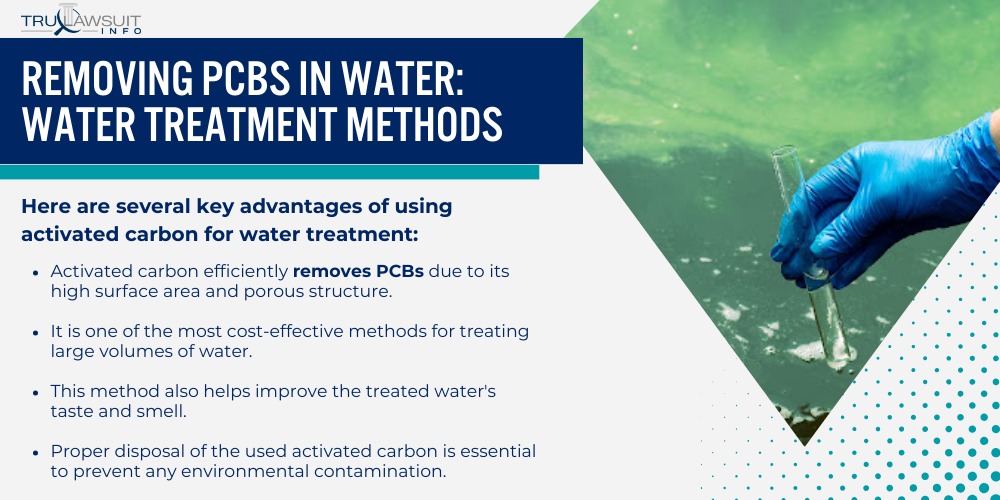
Several water treatment technologies have been designed to remove PCBs, employing chemical filtration, chemical decomposition, and water purification methods.
Adsorption Using Activated Carbon
Using activated carbon is a widespread technique for treating water contaminated with PCBs.
Adsorption is a process where contaminants in water are trapped onto the surface of the carbon material.
Here are several key advantages of using activated carbon for water treatment:
- Activated carbon efficiently removes PCBs due to its high surface area and porous structure.
- It is one of the most cost-effective methods for treating large volumes of water.
- This method also helps improve the treated water’s taste and smell.
- Proper disposal of the used activated carbon is essential to prevent any environmental contamination.
Advanced Oxidation Processes (AOPs)
Advanced Oxidation Processes, or AOPs, involve the generation of highly reactive radicals that can degrade PCBs in water through chemical decomposition.
To understand the advantages and characteristics of AOPs, consider the following points:
- AOPs effectively break down complex organic compounds like PCBs into less harmful substances.
- They include various treatment methods, such as ozone, peroxide, or UV light.
- The effectiveness of AOPs depends on the design and combination of the oxidation systems.
- These processes can be more expensive than other treatment methods but are highly effective for resistant contaminants.
Membrane Filtration Techniques
Membrane filtration is a water purification technique that employs semipermeable membranes to separate PCBs from water.
Exploring the spectrum of membrane filtration offers insight into its versatility and effectiveness:
- Membrane technologies include microfiltration, ultrafiltration, nanofiltration, and reverse osmosis.
- They are known for their precision in removing many pollutants, including PCBs.
- These techniques can be tailored depending on the nature and concentration of the PCB contaminants in water.
- While effective, maintenance of the membrane systems and the handling of the concentrated waste are important considerations in this technology.
Innovative Technologies for Remediation of PCBs in Water
Innovative remediation technologies are pivotal in addressing the persistent challenge of PCBs in water ecosystems.
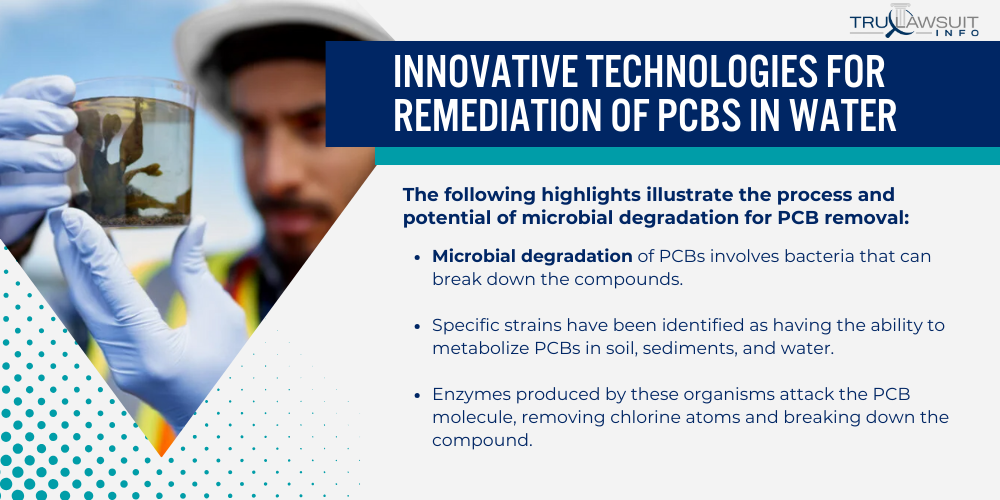
What are PCBs and Their Chemical Properties?
Polychlorinated biphenyls (PCBs) are synthetic organic chemicals comprising chlorine atoms attached to biphenyl, which is two benzene rings.
The number of chlorine atoms can vary, resulting in different PCB congeners.
Their chemical stability and non-flammability led to widespread industrial use before the environmental impacts were fully understood.
Chemical stability also makes them resistant to typical environmental degradation processes, thus posing long-term ecological and health risks.
Bioremediation Using Microorganisms
Bioremediation harnesses the natural biological treatment processes of microorganisms to degrade environmental contaminants.
The following highlights illustrate the process and potential of microbial degradation for PCB removal:
- Microbial degradation of PCBs involves bacteria that can break down the compounds.
- Specific strains have been identified as having the ability to metabolize PCBs in soil, sediments, and water.
- Enzymes produced by these organisms attack the PCB molecule, removing chlorine atoms and breaking down the compound.
- This approach turns commercial pcb mixtures into less harmful substances, though complete dechlorination is a challenge that is still being researched.
Using biological agents promotes a natural and often more cost-effective solution, though managing and enhancing the process requires careful monitoring.
Nanotechnology-Based Approaches for PCB Removal
Nanotechnology offers promising emerging technologies for the clean-up of PCBs in water.
Consider the following advancements in nanotechnology that underscore its potential in addressing PCB contamination:
- Nanomaterials can adsorb or react with PCB molecules, leading to their removal.
- Certain nanostructured materials are employed to sequester PCBs from contaminated sites effectively.
- Reactive nanoparticles like zero-valent iron can promote dechlorination and degrade PCBs.
- Nanotechnology also lends itself to developing sensors for detecting and monitoring PCB concentrations in the environment.
These innovative nanotech applications point towards solutions that could address PCB contamination with high specificity and efficiency.
Case Studies of PCB-Contaminated Water Sites
The following subsections overview three significant PCB-contaminated water sites in the United States.
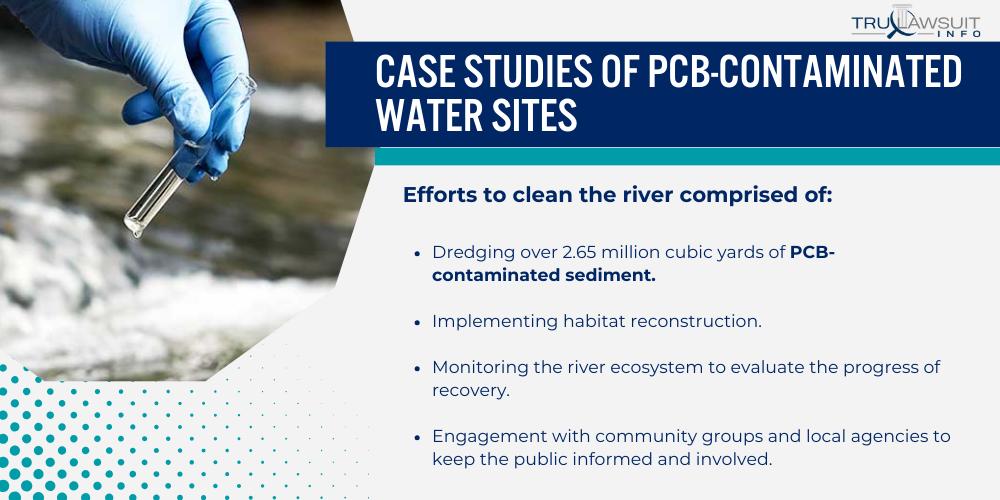
Each case study demonstrates the challenges and strategies involved in sediment remediation and the complexities surrounding superfund sites.
Hudson River PCB Cleanup Project
The Hudson River in New York has been the focus of a large-scale environmental remediation effort due to industrial pollution primarily by individual chlorinated biphenyl components.
Efforts to clean the river comprised of:
- Dredging over 2.65 million cubic yards of PCB-contaminated sediment.
- Implementing habitat reconstruction.
- Monitoring the river ecosystem to evaluate the progress of recovery.
- Engagement with community groups and local agencies to keep the public informed and involved.
Sediment management has been instrumental in curbing the spread of contaminants, demonstrating the site’s gradual return to a safer environmental state.
Kalamazoo River Superfund Site Remediation
The Kalamazoo River in Michigan is another superfund site where extensive sediment remediation was necessary due to PCB contamination from paper mill operations.
Highlights of the remediation project include:
- Remove approximately 450,000 cubic yards of contaminated sediment and riverbank soil.
- Constant water monitoring to ensure compliance with safety standards.
- Capping areas of the riverbed to isolate remaining contaminants.
- Long-term efforts to restore wildlife habitats affected by pollution.
This cleanup has underscored the importance of sustainable sediment management and its role in protecting both human health and the environment.
Duwamish Waterway Sediment Cleanup Efforts
Seattle’s Duwamish Waterway has seen significant cleanup activities to address decades of industrial pollution.
The remediation strategy has incorporated the following:
- Active cleanup of approximately 700,000 cubic yards of contaminated sediment.
- Use of innovative technologies to treat toxic substances.
- Work with local communities to ensure that health risks are minimized.
- Studies to track the effectiveness of the cleanup and ensure long-term sustainability.
The Duwamish Waterway embodies the need for a continued commitment to environmental remediation to ensure the safety of urban waterways plagued by past industrial activities.
Preventing Future Spread of PCBs in Water
The persistence of PCBs in aquatic environments necessitates proactive strategies to prevent contamination.
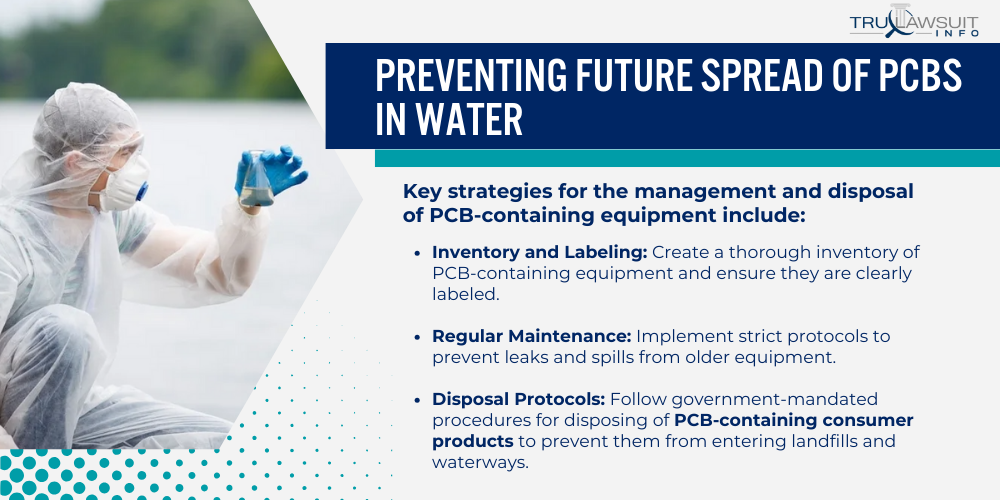
This section delves into the specifics of such strategies, focusing on disposal management, stormwater handling, and public education.
Proper Disposal and Management of PCB-Containing Equipment
Effective hazardous waste disposal is essential in preventing PCBs from entering water systems.
Industry and government regulations must align to ensure PCB-containing equipment’s safe handling and disposal.
Key strategies for the management and disposal of PCB-containing equipment include:
- Inventory and Labeling: Create a thorough inventory of PCB-containing equipment and ensure they are clearly labeled.
- Regular Maintenance: Implement strict protocols to prevent leaks and spills from older equipment.
- Disposal Protocols: Follow government-mandated procedures for disposing of PCB-containing consumer products to prevent them from entering landfills and waterways.
- Upgrading Infrastructure: Invest in and facilitate the transition to PCB-free equipment across all industries.
Stormwater Management and Erosion Control Measures
Efficient water management techniques can mitigate the spread of PCBs through soil and stormwater runoff.
Erosion control is also vital to maintain the integrity of the soil, which can act as a sink for PCBs, preventing them from leaching into water bodies.
Effective strategies to manage stormwater and control erosion include:
- Construct Wetlands: Use natural and artificial wetlands to treat stormwater runoff, which may contain PCBs.
- Green Infrastructure: Implement rain gardens and permeable pavements to reduce runoff and promote groundwater recharge.
- Sediment Control: Adopt sediment control practices like silt fences and sediment basins in construction areas.
- Buffer Zones: Establish vegetative buffer zones along waterways to filter runoff and trap potential contaminants.
PCBs in Water: Public Education and Awareness Campaigns
Public awareness and education are vital in reducing PCB contamination.
Clear information dissemination empowers communities to participate in educational initiatives and take action.
To enhance public understanding and engagement, the following initiatives have been implemented:
- Community Workshops: Host workshops to educate the public on the dangers of PCBs and how to identify PCB-containing products.
- Educational Material: Distribute informative brochures and online resources detailing the risks and prevention methods.
- School Programs: Integrate PCB education into school curricula to instill environmental stewardship from a young age.
- Reporting Mechanisms: Implement and promote reporting channels and PCB advisories for the public to notify authorities about suspected PCB pollution.
Trulawsuit Info: #1 PCB Contamination Lawyer
Trulawsuit Info is a leading firm offering expert legal advice in cases of PCB water contamination.
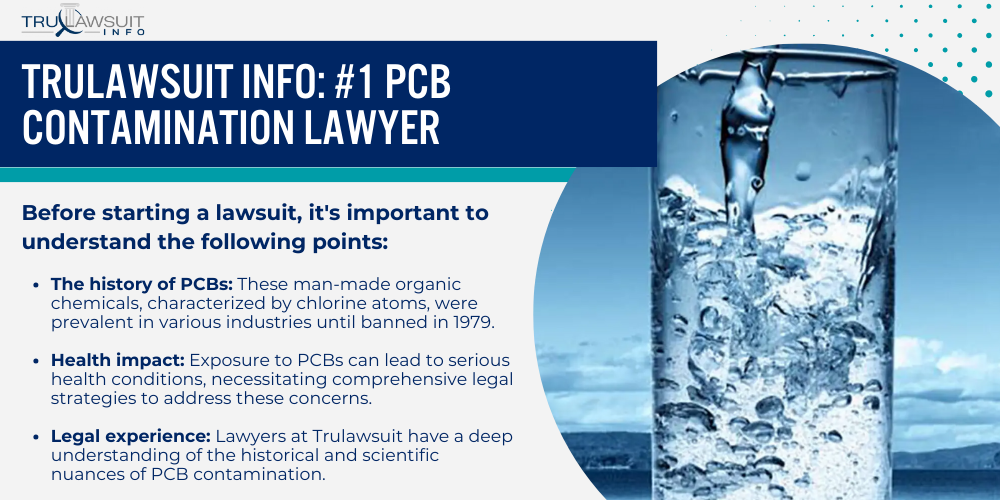
People affected by PCB exposure can consult with lawyers who specialize in environmental law and the PCB regulatory framework.
The legal process might seem overwhelming, but with professional guidance, individuals can seek justice and compensation.
Before starting a lawsuit, it’s important to understand the following points:
- The history of PCBs: These man-made organic chemicals, characterized by chlorine atoms, were prevalent in various industries until banned in 1979.
- Health impact: Exposure to PCBs can lead to serious health conditions, necessitating comprehensive legal strategies to address these concerns.
- Legal experience: Lawyers at Trulawsuit have a deep understanding of the historical and scientific nuances of PCB contamination.
- Regulatory knowledge: They stay abreast of changes in laws and regulations to provide the most current and relevant advice.
Qualifying for a lawsuit entails several steps:
- Documenting exposure and correlating it to health conditions.
- Understanding the link between specific health issues and PCBs.
- Gathering evidence that supports the claim of negligence or improper handling.
- Presenting a well-structured legal argument to seek damages.
People often wonder if they have a case and if their situation warrants legal action.
Trulawsuit Info assists individuals in evaluating their case within the current legal landscape.
They offer a free initial case evaluation, which can be accessed through an easy-to-use chat feature on their website.
It is essential to act promptly, as legal proceedings are subject to statutes of limitations.
Individuals seeking advice should reach out early to ensure the best possible outcome.
Frequently Asked Questions
-
What are the health risks of PCBs in water?
Exposure to PCBs in water, even at low levels, poses health risks, including potential cancer development and neurobehavioral effects.
Studies also point to PCBs disrupting the endocrine system and potentially leading to other chronic health conditions.
-
How can PCBs contaminate fish and other aquatic life?
PCBs enter aquatic ecosystems through industrial discharge and can bioaccumulate in fish and other wildlife.
The fatty tissues of organisms particularly tend to store these contaminants, making them increasingly concentrated as they move up the food chain.
-
In what ways can humans be exposed to PCBs?
Humans are primarily exposed to PCBs through eating contaminated fish and seafood.
Other exposure routes include drinking contaminated water, inhaling air near hazardous waste sites, and using old electrical equipment that contains PCBs.
-
What were the historical uses of PCBs before they were banned?
PCBs were once widely used for their chemical stability and insulating properties in items like transformers, capacitors, and hydraulic systems.
They were also found in thermal insulation materials, paints, and flame retardants before their production was halted due to health concerns.
-
What measures are taken to detect and reduce PCB levels in drinking water?
Regulatory agencies set standards and guidelines for permissible levels of PCBs in water.
Water treatment facilities implement filtration and chemical treatment processes to remove PCBs and routinely monitor water quality to ensure consumer safety.
-
How do PCBs persist in the environment?
PCBs are resistant to chemical, thermal, and biological breakdown, which allows them to persist in the environment for long periods.
They are commonly found in sediments at the bottoms of rivers and lakes and can also be present in soil at industrial sites where they were previously used or disposed of.

Experienced Attorney & Legal SaaS CEO
With over 25 years of legal experience, Jessie is an Illinois lawyer, a CPA, and a mother of three. She spent the first decade of her career working as an international tax attorney at Deloitte.
In 2009, Jessie co-founded her own law firm with her husband – which has scaled to over 30 employees since its conception.
In 2016, Jessie founded TruLaw, which allows her to collaborate with attorneys and legal experts across the United States on a daily basis. This hypervaluable network of experts is what enables her to share reliable legal information with her readers!
Have A Case?
Here, at Tru Lawsuit Info, we’re committed to helping victims get the justice they deserve.
To do this, we actively work to connect them with attorneys who are experts in litigating cases similar to theirs.
Would you like our help?
Tru Lawsuit Info is a reliable source of information about issues that may affect your health and safety, such as faulty products, data breaches, and environmental hazards.
Our team of experienced writers collaborates with medical professionals, lawyers, and advocates to produce informative articles, guides, and other resources that raise awareness of these topics.
Our thorough research provides consumers with access to reliable information and updates on lawsuits happening around the country. We also can connect consumers with attorneys if they need assistance.
Camp Lejeune's water contamination issue spanned several decades starting in the 1950s. Exposure to these chemicals has been linked to various serious health issues, including cancer, organ diseases, and death.
Research is increasingly suggesting a link between the use of Tylenol during pregnancy and the development of neurodevelopmental disorders, such as autism and ADHD, in infants.
Legal action is being taken against manufacturers of Aqueous Film-Forming Foam (AFFF), a chemical used in fighting fires. The plaintiffs allege that exposure to the foam caused health issues such as cancer, organ damage, and birth and fertility issues.
Have A Case?
Here, at Tru Lawsuit Info, we’re committed to helping victims get the justice they deserve.
To do this, we actively work to connect them with attorneys who are experts in litigating cases similar to theirs.
Would you like our help?







